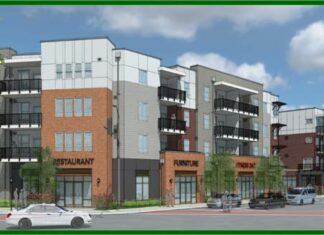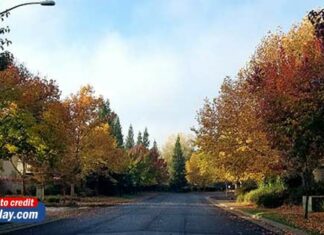Twelve Bridges built in the mid 1880s
Lincoln, Calif.- Much of western Rocklin is astride the southern 12,000 acres of the Spring Valley Ranch of the late 19th and early 20th centuries. Parts of Lincoln and Penryn cover northern parts of the ranch.
Historian Richard Miller, in his Joel Parker Whitney biography, Fortune Built by Gun, tells us that there were 25 miles of roads on the ranch and that “Twelve granite bridges crossed the creeks on the main road from Rocklin to the main headquarters, from there through the vineyard, and around the back end of the ranch.”
Who built these bridges and why? And where are the Twelve Bridges now?
In the early 1870’s, Joel Parker Whitney gained control of the ranch from his father George Whitney who had started the ranch in 1857 with a 320 acre purchase west of what is now Downtown Rocklin. George, Joel Parker, and two of Joel Parker’s five brothers, had prospered at the ranch by producing high quality wool from a special crossbreed of Saxony and Australian Marino sheep. The group had added thousands of acres during the late 1850s and 1860s by preemption and by purchasing property from homesteaders and the railroad.
Joel Parker became wealthy during the 1860s, mainly from his investments in Colorado gold and silver mines. Gilpin County Colorado records show that Joel Parker was a principal in a mining company that filed ownership on more than 150 gold claims in 1865.
Joel Parker traveled widely and continued to invest wisely in the late 19th century, mainly in Colorado mines and California real estate projects.
He traveled to and from Europe often, once famously to the 1867 Paris Universal Worlds Fair and Exhibition as an ambassador from the Colorado territory, promoting investments in Colorado mines. He developed a close relationship with Lucy Chadwick in England in the late 1870’s and fathered a son, J Parker Whitney, by her in London in 1878. A second son, Vincent Whitney, was born while the couple was in New York in 1880.
By the early 1880s, Joel Parker, now in his mid forties, had been through two childless marriages and was ready to settle down with Lucy and the two children. Although he continued to travel frequently, he decided to establish his permanent residence at his Spring Valley Ranch near Rocklin. He married Lucy in Sacramento in 1881.and embarked on a six year project to convert parts of the ranch into a baronial estate for his family.
Joel Parker and Lucy were enamored of Lucy’s English culture and developed their estate with English themes. Later this affinity for things English would motivate Joel Parker to develop the Placer County Citrus Colony, a project to attract Englishmen to the area to buy citrus ranches north and east of the ranch in Clover Valley, Penryn, and Loomis.
Joel Parker flattened about 5 acres on a knoll overlooking the ranch’s headquarters and started construction of his Oaks mansion in 1884. He built tennis courts nearby and set aside 4,200 acres for English-style fox and rabbit hunts. Later he built a golf course on the lower terrain north and east of the Oaks. 1884 also saw the birth of the couple’s youngest child and only daughter, Helen Beryl Whitney.
According to Joel Parker’s records he spent $6,826.46 building stone bridges between 1883 and 1888 while he was building the Oaks and his family’s estate. This is the only period during which his records show bridge construction, so there is little doubt that Joel Parker built his Twelve Bridges in the mid 1880s.
Joel Parker didn’t leave a map showing the location of his bridges, but a map of his Citrus Colony developed in the early 1890s shows the roads and creek crossings which the bridges would probably span. From that map we can estimate fairly closely the route of the road that Miller describes and the possible locations of all of the Twelve Bridges on that road. But where are those bridges now?
There are at nine granite bridges visible in Rocklin’s landscape and three in Lincoln. Six of these have keystone arches as might be seen in stone bridges of the English countryside.
There is a bridge on the seventh hole of the Rocklin Golf Club, barely visible in the rough, almost entirely buried there during course construction in the early 1960s. That bridge is closest to Downtown Rocklin and could be the first bridge on Joel Parker’s road to his headquarters and beyond. There is also a mostly-buried bridge on the eighth hole, possibly the second bridge on that road.
The third bridge is the often photographed centerpiece of Clover Valley Park at the corner of Midas and Clover Valley Road. This is the largest and most picturesque of the known bridges. Contrary to a plaque at the site Joel Parker built this bridge in the mid 1880s.
There are three bridges on the Whitney Oaks Golf Course. One of these is in daily use on the twelfth hole. One is in the rough left of the thirteenth hole and one is out of sight, covered with vegetation, to the right of the fourteenth hole.
There are three bridges in Rocklin’s Mansion Oaks neighborhood. One is in Mansion Oaks Park, disassembled block-by-lock and reassembled there from a location near where Wyckford Avenue crosses Pleasant Grove Creek. Two bridges are in weedy fields nearby; one of these two shows extensive dismantling. The granite blocks in Joel Parker’s bridges are similar to stones used in home landscapes.
There are three granite bridges on the Catta Verdera golf course in Lincoln; none of them have a keystone arch. Two are in daily use; one at the first tee and one crossing the creek on the sixteenth hole. One is out of golfers’ sight, covered by vegetation left of the fifteenth fairway. These three were at the north end of the ranch, out of view of ranch visitors, and not important to the theme of an English countryside.
The granite blocks in all of Joel Parker’s bridges show rough but skillful stone cutting. There is no evidence that Chinese laborers constructed the bridges, although it is possible since many Chinese probably escaped to the ranch as they were expelled from South Placer County population centers during the Chinese purges of September 1877. From Joel Parker’s notes it appears that he might have contracted for construction of his bridges with a local quarry operation employing skilled stone workers.
The granite in the bridges appears to have originated from several places including possibly a now-backfilled quarry on the ranch near the corner of today’s Whitney Oaks Drive and Whitney Ranch Parkway.
(21+ years strong)
Welcome to the brighter side!
Get in front of local customers! 24/7 (365)























